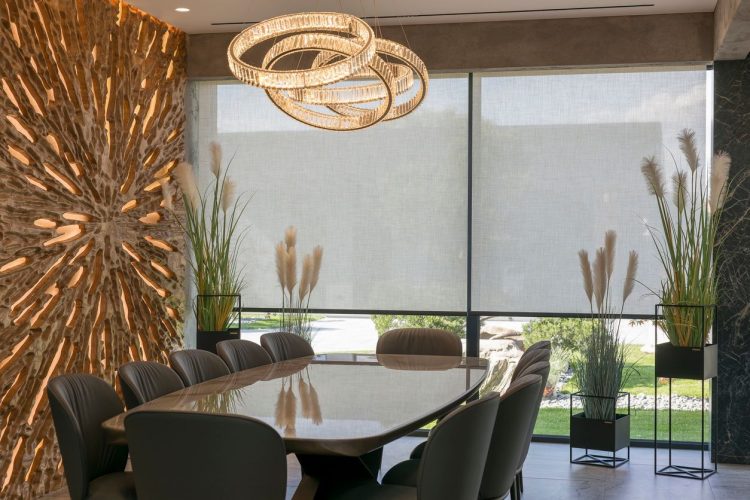Windows can be one of the most dramatic architectural features in a home. Floor-to-ceiling glass walls, panoramic views and oversized panes can blur the boundary between inside and out, making a house feel more expansive, calm and make a statement. This abundance of natural light can also present the challenge of maintaining privacy without compromising on beauty.
Window treatments are more than a practical necessity. They also influence light control, energy efficiency, acoustics and, most importantly, the ambiance of each space. When executed well, window treatments offer a seamless blend of form and function, and elevate a room while also protecting privacy. Here’s how to ensure you approach your window treatments with both elegance and discretion.
Treat window treatments as architectural enhancements
In any home, window treatments shouldn’t feel like afterthoughts or accessories. They should complement your home’s architectural style, enhance areas you want to highlight and compensate for any shortcomings.
Design tips:
- Use ceiling-mounted drapery hardware to elongate the wall and enhance verticality.
- Select fabrics and materials that reflect your home’s overall design, such as linen for casual elegance, velvet for drama or sheer silk for a layered texture.
- Incorporate custom millwork, cornices or recessed valances to conceal hardware and achieve a seamless look.
Prioritize layered treatments for light control and privacy
In homes with expansive windows, a single layer of coverage often fails to provide the desired balance of privacy, light and aesthetics. Layering allows for versatility throughout the day and across seasons. Layered treatments also help absorb sound, which can be a vital detail in large, open-concept homes with echo-prone finishes, such as stone and glass.
Design tips:
- Combine sheer panels for daytime softness with lined drapery or blackout shades for nighttime privacy.
- Use solar shades to preserve views while reducing UV damage and glare during the day.
- For bedrooms or media rooms, install motorized blackout roller shades behind decorative curtains for total light control.
Embrace motorization and smart control
Automated window treatments allow you to control light, temperature and privacy with precision, whether you’re at home or away. You don’t have to limit window treatment automation to the main living areas. The primary suite, bathrooms and guest rooms also benefit from remote-controlled ease.
Design tips:
- Select motorized drapery tracks or smart shades that are integrated with your home automation system.
- Program the window treatments to adjust light and privacy throughout the day, considering how you want to wake up, how you want your evenings to feel,and how you want the house to appear when you’re on vacation.
- Opt for hardwired systems in new builds or extensive remodels for cleaner installations and fewer limitations.
Match privacy strategies to exposure and purpose
Not every room needs the same level of privacy. Well-designed window treatments consider the function and visibility of each space. Privacy can also mean filtering the outside in a way that feels intentional, calming and personalized.
Design tips:
- Use top-down/bottom-up shades in street-facing rooms to block sightlines while allowing light to enter.
- In bathrooms, opt for frosted or textured window films paired with soft Roman shades for both discretion and elegance.
- For secluded spaces with views, use motorized sheers that can soften light without compromising the landscape.
Consider custom solutions for oversized or unique windows
In homes with dramatic window shapes, such as arched, round or corner windows, or entire glass walls, retail window treatments often won’t suffice. Custom treatments can turn challenging windows into signature focal points rather than awkward limitations.
Design tips:
- Work with a designer or fabricator to create custom treatments that fit unusual dimensions or curves.
- Use motorized drapery with tracking systems that follow curved walls or angled glass.
- Incorporate floor-to-ceiling treatments that emphasize proportion and balance, rather than trying to hide large windows.










